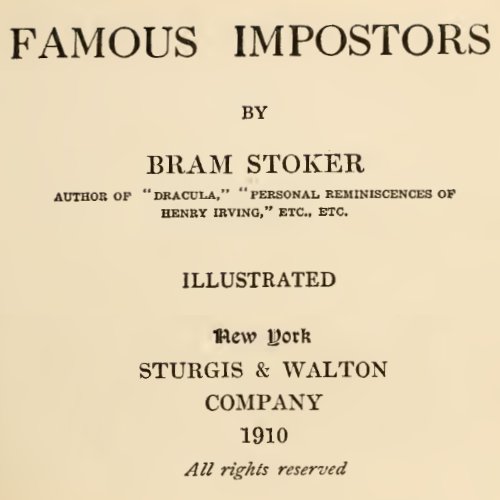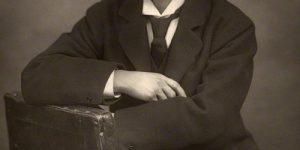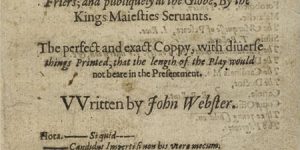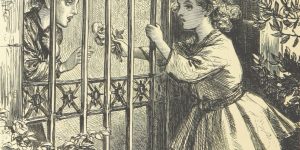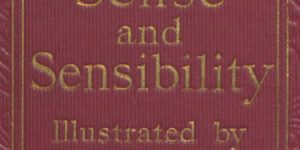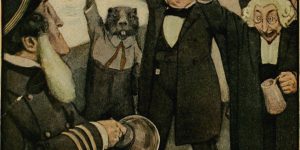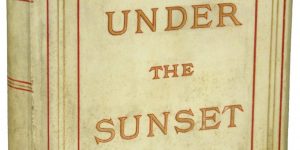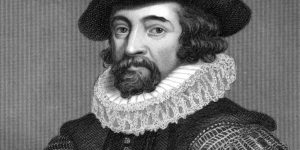Hannah Snell : Famous Impostors by Bram Stoker
Famous Impostors : Women as Men Hannah Snell
by
Bram Stoker
Hannah Snell
Hannah Snell is a good instance of how the life of a woman who was not by nature averse from adventure was moulded by chance in the direction which suited her individuality. Of course, liking for a militant life, whether in conventional or exceptional form, presupposes a natural boldness of spirit, resolution, and physical hardihood—all of which this woman possessed in an eminent degree.
She was born at Worcester in 1723, one of the family of a hosier who had three sons and six daughters. In 1740, when her father and mother were dead, she went to live at Wapping with a sister who had married a ship carpenter named Gray. There she married a Dutch sailor, who before her baby was born, had squandered such little property as her father had left her, and then deserted her. She went back to her sister, in whose house the baby died. In 1743, she made up her mind to search for her husband. To this end she put on man’s clothes and a man’s name (that of her brother-in-law) and enlisted in General Guise’s regiment. At Carlisle, whither the regiment was sent she learned something of a soldier’s duties. In doing so she was selected by her sergeant, a man called Davis, to help him in carrying out a criminal love affair. In order to be able to warn the girl she pretended acquiescence. In revenge the sergeant reported her for an alleged neglect of some duty for which according to the barbarous system of the time she was sentenced to 600 lashes; of these she had actually received 500 when on the intervention of some of the officers the remaining hundred were foregone. After this, fearing further aggression on the part of the revengeful petty officer she deserted. She walked all the way to Portsmouth—a journey which occupied a whole month—where she again enlisted as a marine in Fraser’s regiment, which was shortly ordered on foreign service to the East Indies. There was a storm on the way out, during which she worked manfully at the pumps. When the ship had passed Gibraltar there was another bad storm in which she was wrecked. Hannah Snell found her way to Madeira and thence to the Cape of Good Hope. Her ship joined in the taking of Arcacopong on the Coromandel Coast; in which action Hannah fought so bravely that she was praised by her officers. Later on she assisted in the siege of Pondicherry which lasted nearly three months before it had to be abandoned. In the final attempt she served on picket duty and had to ford, under fire, a river breast high. During the struggle she received six bullets in the right leg, five in the left leg, and one in the abdomen. Her fear was not of death but discovery of her sex through the last-named wound. By the friendly aid of a black woman, however, she avoided this danger. She managed to extract the bullet herself, with her finger and thumb, and the wound made a good cure. This wound caused her a delay of some weeks during which her ship had to leave for Bombay and was delayed five weeks by a leak. Poor Hannah was again unfortunate in her officers; one of them to whom she had refused to sing had her put in irons and given a dozen lashes. In 1749 she went to Lisbon, where she learned by chance that her husband had met at Genoa the death penalty by drowning, for a murder which he had committed. Discovery of her sex and her identity would have been doubly dangerous now; but happily she was able to conceal her alarm and so escaped detection. She got back to London through Spithead and once more found shelter in the house of her sister who at once recognised her in spite of her disguise. Her fine singing voice, which had already caused her to be flogged, now stood her in good stead. She applied for and obtained an engagement at the Royalty theatre, Wellclose square; and appeared with success as Bill Bobstay a sailor and Firelock a soldier. She remained on the stage for some months, always wearing male dress. The government of the day gave her, on account of the hardships she had endured, a pension of £20 per annum. Later on she took a public-house at Wapping. The sign of her hostelry became noted. On one side of it was painted in effigy The British Tar and on the other The Valiant Marine, and underneath The Widow in masquerade, or the Female Warrior.
As Hannah appeared during her adventurous career as both soldier and sailor she affords, in herself, an illustrious example of female courage as well as female duplicity in both of the services.
Famous Impostors
Chapter I. Pretenders
A. Perkin Warbeck
B. The Hidden King
C. Stephan Mali
D. The False Dauphins
E. Princess Olive
Chapter II. Practitioners of Magic
A. Paracelsus
B. Cagliostro
C. Mesmer
Chapter III.
The Wandering Jew
Chapter IV.
John Law
Chapter V. Witchcraft and Clairvoyance
A. Witches
B. Doctor Dee
C. La Voisin
D. Sir Edward Kelley
E. Mother Damnable
F. Matthew Hopkins
Chapter VI.
Arthur Orton (Tichborne claimant)
Chapter VII. Women as Men
A. The Motive for Disguise
B. Hannah Snell
C. La Maupin
D. Mary East
Chapter VIII. Hoaxes, etc.
A. Two London Hoaxes
B. The Cat Hoax
C. The Military Review
D. The Toll-Gate
E. The Marriage Hoax
F. Buried Treasure
G. Dean Swift’s Hoax
H. Hoaxed Burglars
I. Bogus Sausages
J. The Moon Hoax
Chapter IX.
Chevalier d’Eon
Chapter X.
The Bisley Boy

